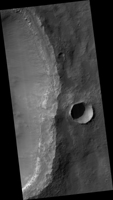
|
Colorful Layers in a Crater Wall
- Click the image above for a larger view
- Full-Res JPEG (2880 x 1800) (703.9 kB)
- Full-Res TIFF (2880 x 1800) (15.6 MB)
Caption:

Map Projected Browse Image
Click on image for larger version
Impact craters are natural "road cuts," exposing planetary layers in cross-section. However, the violent process of impact can also disrupt existing layers.
A kilometer-wide cutout shows layers sloping from the crater's rim at right downward toward its floor off to the left. A gradient of enhanced colors indicates diverse compositions. Clay minerals have been detected here, and one interpretation is that they formed through weathering under a wetter ancient climate, with layers near the surface having more water-altered compositions than deeper ones. Another interpretation is that the layers of different compositions were laid down at different times, from different processes and source materials.
Elsewhere, the lower layers appear abruptly offset along a fault, a common feature in impact craters of this size (roughly 20 kilometers). In addition, the upper layers show a patchy distribution of colors, with some blocks that might have been ejected from deeper locations within the crater during impact.
The map is projected here at a scale of 50 centimeters (19.7 inches) per pixel. (The original image scale is 51.3 centimeters [20.2 inches] per pixel [with 2 x 2 binning]; objects on the order of 154 centimeters [60.6 inches] across are resolved.) North is up.
Background Info:
The University of Arizona, in Tucson, operates HiRISE, which was built by Ball Aerospace & Technologies Corp., in Boulder, Colorado. NASA's Jet Propulsion Laboratory, a division of Caltech in Pasadena, California, manages the Mars Reconnaissance Orbiter Project for NASA's Science Mission Directorate, Washington.
Cataloging Keywords:
| Name | Value | Additional Values |
|---|---|---|
| Target | Mars | |
| System | ||
| Target Type | Planet | |
| Mission | Mars Reconnaissance Orbiter (MRO) | |
| Instrument Host | Mars Reconnaissance Orbiter | |
| Host Type | Orbiter | |
| Instrument | High Resolution Imaging Science Experiment (HiRISE) | |
| Detector | ||
| Extra Keywords | Color, Crater, Impact, Map, Water | |
| Acquisition Date | ||
| Release Date | 2021-08-20 | |
| Date in Caption | ||
| Image Credit | NASA/JPL-Caltech/University of Arizona | |
| Source | photojournal.jpl.nasa.gov/catalog/PIA24861 | |
| Identifier | PIA24861 | |
